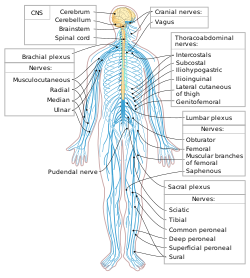Peripheral nervous system
This article needs additional citations for verification. (May 2020) |
| Peripheral nervous system | |
|---|---|
 The human nervous system. Sky blue is PNS; yellow is CNS. | |
| Identifiers | |
| Acronym(s) | PNS |
| MeSH | D017933 |
| TA98 | A14.2.00.001 |
| TA2 | 6129 |
| FMA | 9093 |
| Anatomical terms of neuroanatomy | |
The peripheral nervous system (PNS) is one of two components that make up the
The peripheral nervous system can be divided into the
Structure
The peripheral nervous system is divided into the somatic nervous system, and the autonomic nervous system. The somatic nervous system is under voluntary control, and transmits signals from the brain to end organs such as muscles. The sensory nervous system is part of the somatic nervous system and transmits signals from senses such as taste and touch (including fine touch and gross touch) to the spinal cord and brain. The autonomic nervous system is a "self-regulating" system which influences the function of organs outside voluntary control, such as the heart rate, or the functions of the digestive system.
Somatic nervous system
This section needs additional citations for verification. (May 2020) |
The somatic nervous system includes the sensory nervous system and the somatosensory system and consists of sensory nerves and somatic nerves, and many nerves which hold both functions.
In the
For the rest of the body, spinal nerves are responsible for somatosensory information. These arise from the spinal cord. Usually these arise as a web ("plexus") of interconnected nerves roots that arrange to form single nerves. These nerves control the functions of the rest of the body. In humans, there are 31 pairs of spinal nerves: 8 cervical, 12 thoracic, 5 lumbar, 5 sacral, and 1 coccygeal. These nerve roots are named according to the spinal vertebrata which they are adjacent to. In the cervical region, the spinal nerve roots come out above the corresponding vertebrae (i.e., nerve root between the skull and 1st cervical vertebrae is called spinal nerve C1). From the thoracic region to the coccygeal region, the spinal nerve roots come out below the corresponding vertebrae. This method creates a problem when naming the spinal nerve root between C7 and T1 (so it is called spinal nerve root C8). In the lumbar and sacral region, the spinal nerve roots travel within the dural sac and they travel below the level of L2 as the cauda equina.
Cervical spinal nerves (C1–C4)
The first 4 cervical spinal nerves, C1 through C4, split and recombine to produce a variety of nerves that serve the neck and back of head.
Spinal nerve C1 is called the suboccipital nerve, which provides motor innervation to muscles at the base of the skull. C2 and C3 form many of the nerves of the neck, providing both sensory and motor control. These include the
The phrenic nerve is a nerve essential for our survival which arises from nerve roots C3, C4 and C5. It supplies the thoracic diaphragm, enabling breathing. If the spinal cord is transected above C3, then spontaneous breathing is not possible.[citation needed]
Brachial plexus (C5–T1)
The last four cervical spinal nerves, C5 through C8, and the first thoracic spinal nerve, T1, combine to form the
Lumbosacral plexus (L1–Co1)
The

Autonomic nervous system
The
Sympathetic nervous system
The
Parasympathetic nervous system
Primarily using the neurotransmitter
Enteric nervous system
There is a lesser known division of the autonomic nervous system known as the enteric nervous system.[9] Located only around the digestive tract, this system allows for local control without input from the sympathetic or the parasympathetic branches, though it can still receive and respond to signals from the rest of the body.[9] The enteric system is responsible for various functions related to gastrointestinal system.[9]
Disease
Diseases of the peripheral nervous system can be specific to one or more nerves, or affect the system as a whole.
Any peripheral nerve or nerve root can be damaged, called a
See also
- Classification of peripheral nerves
- Connective tissue in the peripheral nervous system
- Preferential motor reinnervation
References
- ISBN 9781416062578.
- ^ "Slide show: How your brain works - Mayo Clinic". mayoclinic.com. Retrieved 17 June 2016.
- OCLC 1048014796.)
{{cite book}}: CS1 maint: location missing publisher (link - ISBN 9781266041846.
- ISBN 978-0-7817-7245-7.
- ISBN 978-0-07-149623-0. Retrieved 17 November 2010.
- OCLC 1119065904.)
{{cite book}}: CS1 maint: location missing publisher (link) CS1 maint: others (link - ^ ISSN 1479-9189.[permanent dead link]
- ^ ISSN 1075-6361.[permanent dead link]
This article needs additional citations for verification. (November 2007) |
External links
- Peripheral nervous system photomicrographs
- Peripheral Neuropathy Archived 2016-12-15 at the Wayback Machine from the US NIH
- Neuropathy: Causes, Symptoms and Treatments from Medical News Today
- Peripheral Neuropathy at the Mayo Clinic
